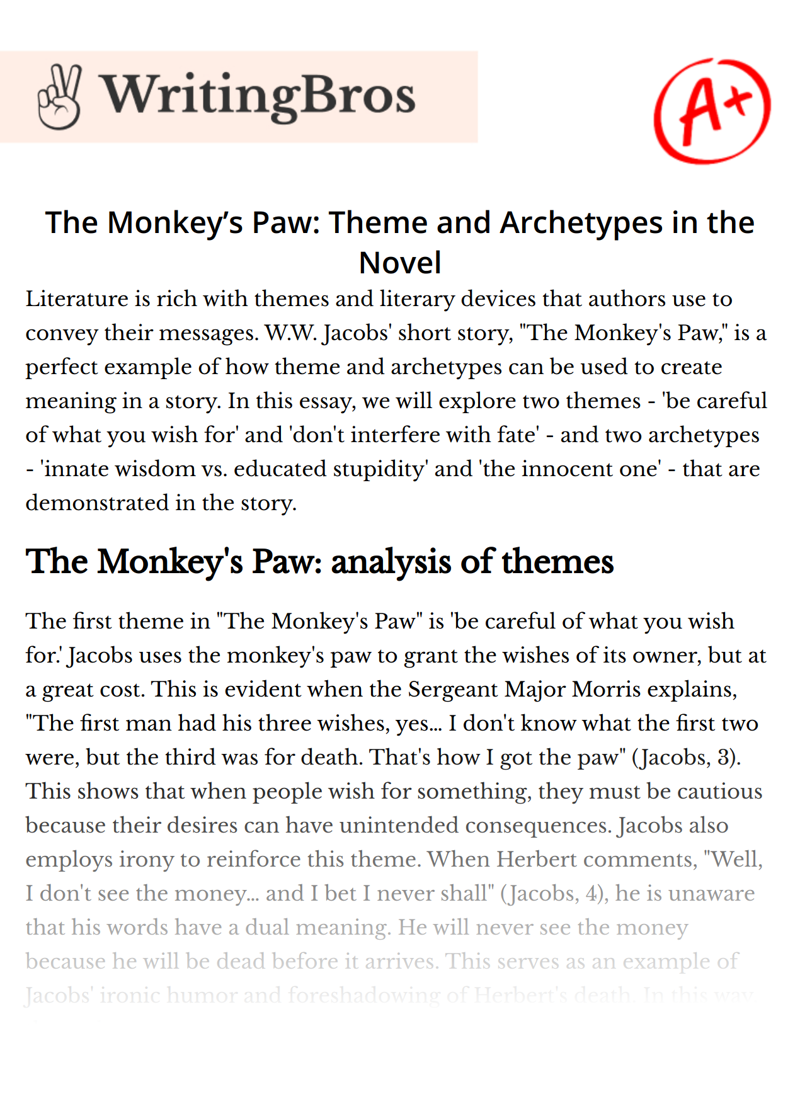The Monkey’s Paw: Theme and Archetypes in the Novel

Table of contents
- The Monkey's Paw: analysis of themes
- Archetypes
- References
Literature is rich with themes and literary devices that authors use to convey their messages. W.W. Jacobs' short story, "The Monkey's Paw," is a perfect example of how theme and archetypes can be used to create meaning in a story. In this essay, we will explore two themes - 'be careful of what you wish for' and 'don't interfere with fate' - and two archetypes - 'innate wisdom vs. educated stupidity' and 'the innocent one' - that are demonstrated in the story.
The Monkey's Paw: analysis of themes
The first theme in "The Monkey's Paw" is 'be careful of what you wish for.' Jacobs uses the monkey's paw to grant the wishes of its owner, but at a great cost. This is evident when the Sergeant Major Morris explains, "The first man had his three wishes, yes… I don't know what the first two were, but the third was for death. That's how I got the paw" (Jacobs, 3). This shows that when people wish for something, they must be cautious because their desires can have unintended consequences.
Jacobs also employs irony to reinforce this theme. When Herbert comments, "Well, I don't see the money… and I bet I never shall" (Jacobs, 4), he is unaware that his words have a dual meaning. He will never see the money because he will be dead before it arrives. This serves as an example of Jacobs' ironic humor and foreshadowing of Herbert's death. In this way, the author warns readers about the dangers of greed and the consequences of trying to change fate.
The second theme is 'don't interfere with fate.' Jacobs uses the monkey's paw as a symbol of fate, warning readers not to try to alter their destiny. The Sergeant Major Morris advises Mr. White, "If you keep it, don't blame me for what happens. Pitch it on the fire again, like a sensible man" (Jacobs, 3). This illustrates that sometimes, it is best to accept one's fate and not try to change it, as doing so can lead to disastrous outcomes.
Archetypes
The story also contains two archetypes, 'innate wisdom vs. educated stupidity' and 'the innocent one.' The first archetype is embodied by the Sergeant Major Morris and Mr. White. The Sergeant Major represents innate wisdom because he understands the consequences of using the paw and tries to protect Mr. White from its dangers. In contrast, Mr. White represents educated stupidity because he is aware of the paw's potential harm, but chooses to ignore it for personal gain.
The second archetype is demonstrated by Mrs. White, who represents 'the innocent one.' She initially doubts the paw's abilities, but eventually comes to believe in its power. When her son dies, she wishes for him to return, not fully realizing the potential consequences of her wish. This highlights the dangers of naivety and shows that sometimes, people must accept the inevitable and not try to change it.
In conclusion, W.W. Jacobs' "The Monkey's Paw" is a cautionary tale that warns readers about the consequences of meddling with fate and the dangers of wishing for things without considering the potential costs. Through the themes of 'be careful of what you wish for' and 'don't interfere with fate,' and the archetypes of 'innate wisdom vs. educated stupidity' and 'the innocent one,' Jacobs creates a complex and thought-provoking story that continues to resonate with readers today.
References
- Jacobs, W. W. (1902). The monkey's paw. Harper's Monthly Magazine, 105(629), 525-529.
- Armstrong, J. (2015). The monkey’s paw by W. W. Jacobs. Masterpieces of Terror and the Unknown, 125-131.
- Brennan, M. (2018). Archetypes in Literature: Examples and Explanations. Udemy. Retrieved from https://www.udemy.com/blog/archetypes-in-literature/
- Frye, N. (1957). Anatomy of Criticism. Princeton University Press.
- Lye, J. (2014). Some possible interpretations for W.W. Jacobs' short story The Monkey's Paw. Luminarium. Retrieved from https://www.luminarium.org/contemporary/monkeyspaw/interpretations.php
Cite this Essay
To export a reference to this article please select a referencing style below

